"Only those who dare to fail greatly will ever achieve greatly."
- John F. Kennedy
Indiana Bioptic Driving Program: An Overview
The Indiana Bioptic driving program has served as a model for a number of states in the U.S. It was designed to provide a number of checks and balances to ensure that bioptic drivers reach independence, but with safety as the critical issue.
The Low Vision Examination: The first step is a careful examination by a l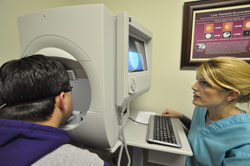 ow vision specialist, either an ophthalmologist or optometrist who specializes in low vision rehabilitation. In addition to a medical history, a careful driving history will be conducted. The doctor will test the vision, eye health, visual fields and evaluate the patient with bioptic system. The doctor will determine whether the patient has the potential to meet the guidelines for the Indiana bioptic program.
ow vision specialist, either an ophthalmologist or optometrist who specializes in low vision rehabilitation. In addition to a medical history, a careful driving history will be conducted. The doctor will test the vision, eye health, visual fields and evaluate the patient with bioptic system. The doctor will determine whether the patient has the potential to meet the guidelines for the Indiana bioptic program.
Indiana BMV Bioptic Requirements: The visual acuity requirements of no less than 20/200 in one eye and an ability to read the 20/40 line with the bioptic system are required. Additionally, the patient must demonstrate 120 degrees of horizontal visual field and an ability to discriminate traffic signs and signals. Other mental or physical problems are evaluated as well that might interfere with driving. Bioptic driving rules vary in each state though several states have patterned their programs after Indiana.
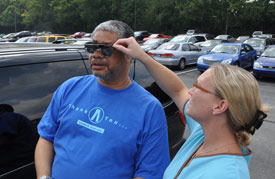 Fitting and Training with the Bioptic System: If the patient meets the criteria and elects to go forward, the low vision specialist will prescribe the appropriate bioptic system for the patient. They will then fit and train the patient. The Low Vision Centers of Indiana have developed an extensive training program with a training manual and CD based self-extracting materials to help the patient with spotting through the bioptic and recognizing signs.
Fitting and Training with the Bioptic System: If the patient meets the criteria and elects to go forward, the low vision specialist will prescribe the appropriate bioptic system for the patient. They will then fit and train the patient. The Low Vision Centers of Indiana have developed an extensive training program with a training manual and CD based self-extracting materials to help the patient with spotting through the bioptic and recognizing signs.
We teach patients how to spot a stationary target while stationery and to spot moving 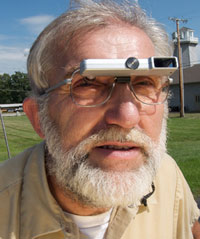 targets while stationary. Then the patient is taught to spot stationary targets while the patient is moving and spot moving targets while the patient is moving. The patient is also taught to appreciate the image size and image movement characteristics of the bioptic and to appreciate the change in spatial relationships. Objects viewed through the bioptic will seem closer. Additionally, how to use the mirrors is practiced. Most times the bioptics are not used in the mirror, but occasional they are needed.
targets while stationary. Then the patient is taught to spot stationary targets while the patient is moving and spot moving targets while the patient is moving. The patient is also taught to appreciate the image size and image movement characteristics of the bioptic and to appreciate the change in spatial relationships. Objects viewed through the bioptic will seem closer. Additionally, how to use the mirrors is practiced. Most times the bioptics are not used in the mirror, but occasional they are needed.
Therapies include incorporating “real world” experiences as a passenger. They must be able to glance into the telescope and detect and remember what they see in only one to two seconds and still be aware of what is going on around them. This happens when we look into the rearview mirror. We see the image in the mirror, but are still aware of our general road position. This has been termed multiplexing by Dr. Eli Peli, researcher and inventor at Harvard’s Schepens Eye Research Insitute.
Another training method is descriptive driving. In descriptive driving, the patient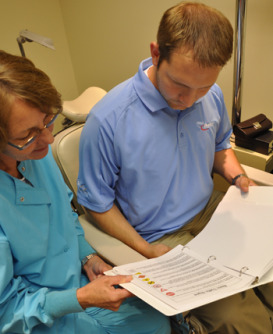 rides as a passenger with the bioptics on and announces what is seen including road signs, cars, people etc. The driver provides feedback by pointing out anything not seen or identified incorrectly.
rides as a passenger with the bioptics on and announces what is seen including road signs, cars, people etc. The driver provides feedback by pointing out anything not seen or identified incorrectly.
Training is carefully documented. Once the patient has learned how to use the system effectively, the doctor will complete the appropriate application and release the patient for behind-the-wheel evaluation and training with an approved driving rehabilitation specialist.
Driving Rehabilitation Evaluation: Indiana has driving rehab programs approved for bioptic drivers in Indianapolis, Fort Wayne, South Bend, Columbus and Clinton. The driving rehabilitation specialist will perform an extensive assessment of driving skills and then perform a behind-the-wheel evaluation. If the patient passes this evaluation, the doctor’s application and the driving rehab specialist recommendations and report will be forwarded to the BMV.
Driver’s License Permit: If approved by the BMV, a bioptic driving permit will be issued. It is valid only with the driving rehabilitation specialist. If this is a new driver or if the license has been expired more that 6 months, the patient will need to take the state written examination.
Behind-the-wheel driver’s training: Bioptic drivers must train with a driving rehabilitation specialist for a minimum of 30 hours. Some patients may require more time. The patient will usually begin as 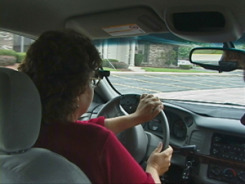 a passenger proving their ability to use the bioptic system. Then they will become the driver in specially equipped cars with an extra brake for the driving specialist. They will begin with low volume traffic areas and slowly proceed to more complex situations over the course of their training. During training different levels of traffic, weather and pedestrian volume will be encountered. If they successfully complete the behind-the-wheel training portion, the patient will then proceed to an extended driving evaluation by the BMV.
a passenger proving their ability to use the bioptic system. Then they will become the driver in specially equipped cars with an extra brake for the driving specialist. They will begin with low volume traffic areas and slowly proceed to more complex situations over the course of their training. During training different levels of traffic, weather and pedestrian volume will be encountered. If they successfully complete the behind-the-wheel training portion, the patient will then proceed to an extended driving evaluation by the BMV.
The BMV Driving Test: The BMV will perform an extended behind-the-wheel evaluation. These behind-the-wheel tests are performed by driving evaluators that work daily with drivers that have different mild impairments. They are familiar with bioptic driving.
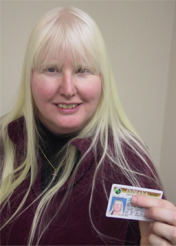 Licensure: The BMV is the final determinant of licensure. Most patients must be seen annually by the doctor to ensure they continue to meet the requirements. The doctor will submit the appropriate paperwork to the BMV. Annual behind-the-wheel evaluations are not required unless requested by the doctor or the patient has a history of accidents.
Licensure: The BMV is the final determinant of licensure. Most patients must be seen annually by the doctor to ensure they continue to meet the requirements. The doctor will submit the appropriate paperwork to the BMV. Annual behind-the-wheel evaluations are not required unless requested by the doctor or the patient has a history of accidents.
One of the most important areas is that we provide substantial training by the doctor and his/her staff and then by an approved driving rehabilitation specialist. Some states allow patients to take the vision test with their telescopes, but do not require training or a behind-the-wheel evaluation. While this may seem good to a patient eager to obtain a driver’s license, the level of safety would be a great concern. It is important that all drivers receive adequate training before licensure.
The Low Vision Centers of Indiana
Richard L. Windsor O.D., F.A.A.O., D.P.N.A.P.
Craig Allen Ford O.D., F.A.A.O.
Laura Kathleen Windsor. O.D., F.A.A.O.
